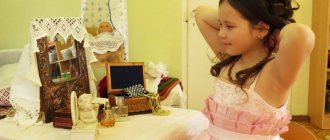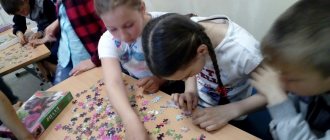Card index of didactic games for FCCM (senior group)
CARD INDEX OF DIDACTIC GAMES
on cognitive development
(Formation of a holistic picture of the world)
(senior group)
1.
“What are objects made of?”
Target:
To achieve clarification of children's knowledge about the materials from which objects are made.
Materials.
Wooden soldier, iron cart, paper man.
Content.
The game is based on the plot of a fairy tale. The central figure is Santa Claus. For this role you need to choose a child with well-developed speech. Santa Claus needs a lot of toys to give to children for the Christmas tree, but there is nothing to make them from. Therefore, he sends his assistants around the world - the “Wooden Soldier”, “Iron Cart” and “Paper Man”, so that they bring ready-made toys or objects from which toys can be made. The “Wooden Soldier” has the right to bring only wooden objects, the “Iron Cart” - only iron ones, and the “Paper Man” - paper ones. Santa Claus checks whether they brought the items correctly. Helpers should rotate so that as many children as possible participate in the game.
2.
“Exhibition”
Purpose:
ensure the development of children’s ability to determine what material objects are made of (wood, glass, metal).
Materials:
various objects made of wood, glass, metal, material, etc.
Content.
Items are laid out on the table. The teacher explains to the children what objects are made of. 3-4 participants in the game are called to choose objects made of wood or glass, then all the objects are distributed to the children. Then the teacher asks to return all the objects, and arrange them in a certain system, for example, all wooden things in one row, metal ones in another, etc.
3.
“What animal is this?”
Target:
systematize children's knowledge about animals, describing animals according to the most typical characteristics.
Content.
One of the children is the driver. He thinks of an animal and describes it: “This is a white animal, it has 4 legs, horns, and a short tail. It gives milk." The rest of the children guess. Whoever guesses first gets the right to make a wish.
4.
“How do we dress?”
Target:
systematize knowledge about individual parts of clothing and skills for their proper use.
Content.
Every child thinks of some piece of clothing, for example, a scarf, a skirt. Dress, gloves, T-shirt, etc. and names them only to the teacher, so that the other children do not hear (the teacher makes sure that several children do not choose the same item).
Then one child talks about something. For example: “I was going sledding and put it on myself...” Interrupting the story, he points to some participant in the game. He names the piece of clothing he has in mind. The rest of the children must judge whether the boy or girl dressed correctly. This game is very funny, as sometimes you get funny phrases.
5.
“Find the kids”
Goal:
systematize children's knowledge about the names of baby animals.
Material:
pictures of animals and their babies.
Content.
The child is given a picture of an animal, and he must find a picture with a baby of this animal and name it correctly. After this, you can invite the children to divide the animals into 2 groups: domestic animals and wild ones.
6.
“What grows in the forest?”
Target:
systematize children's knowledge about forest or garden plants.
Content.
The teacher selects three children and asks them to name what grows in the forest. For example, one says “mushrooms”, the second says “raspberries”, the third says “spruce”, and then the first one continues again. The teacher warns. That you can’t think for a long time. When the players break a rule, they sit down and choose a replacement. The new troika receives another task, for example, to list what grows in the garden, or who lives in the forest, in the yard, etc.
7.
“Gardener”
Purpose:
ensure the practical application of the ability to identify the characteristic features of fruits, vegetables, and flowers.
Materials:
pictures depicting flowers, vegetables, fruits.
Content.
Children sit around a table on which pictures are placed face down. One child is a gardener. With a watering can or some other typical gardener's object, he goes around the children and says: “I have a big garden. Come to me, Anechka, pick something.”
The child, whom the gardener calls to the table, chooses a picture for himself, looks at it and then describes it so that the children guess which plant is picked. Then the child who drew the picture becomes the gardener, and the game continues until all the pictures are sorted out.
8.
“Vegetables”
Purpose:
systematize children's knowledge about various vegetables.
Materials:
pictures depicting vegetables, cut into several parts.
Content.
Children put together pictures of the parts and say what these vegetables are called, what color or taste they are, and what they are used for.
9.
“Seek and you will find”
Purpose:
practice distinguishing the characteristic features of individual seasons.
Materials:
pictures depicting native nature in different seasons.
Content.
Children classify the pictures and put them next to each other, depending on whether they belong to spring, summer, autumn or winter.
10.
“Fruits and vegetables”
Purpose:
systematize children's ideas about fruits and vegetables.
Materials:
cards with pictures of fruits and vegetables.
Content.
— The teacher lays out cards on the table, and the children must divide them into 2 groups: fruits and vegetables.
— The teacher selects one card and shows it to the children. Children must say what is drawn on the card and which group it should be assigned to (for example, pear is a fruit).
- The teacher names some fruit or vegetable, and the children must find it and indicate which group it belongs to (for example, find carrots, onions, cherries, etc.)
- Compare the images on the card with real fruits or vegetables. For example, using a card with a picture of an onion on it, find a real one.
— The cards are placed face down. One child chooses a card and tells what is written on it. The rest of the children guess from the description what it is.
— The teacher hands out cards to the children and says: “All children whose cards show fruits (vegetables) raise the picture.”
11.
“Who likes what?”
Target:
clarify children's knowledge of what individual animals eat.
Materials:
pictures with animals and pictures with different types of food (carrots, grass, cabbage, milk, bones, etc.).
Content.
The teacher sits a small group of children around the table. First of all, she introduces them to pictures of animals, then gives the children pictures of animal food. After this, the teacher shows the children, for example, a cow and offers to find food for it.
12. «Guess what's in the bag"
Target:
describe the signs perceived by touch.
Materials:
vegetables and fruits of characteristic shapes and varying densities (onions, turnips, radishes, beets, tomatoes, plums, apples, pears, etc.) are placed in a bag.
Content.
The teacher invites one of the children to take an object out of the bag, but not to pull it out, but to feel it and name its characteristic features. The child tells, all children name an object that they do not yet see, after which the child takes it out of the bag and shows what is in his hand. The named item is not put back into the bag.
13.
“The postman brought a parcel”
Purpose:
contribute to the development of the ability to describe objects and recognize them by description.
Materials:
The teacher puts vegetables and fruits one at a time into paper bags and then places them in a box.
Content.
The box (parcel) is brought to the group. The teacher says: “Today the postman brought us a parcel. It contains different vegetables and fruits.” The teacher gives several children a bag and asks them to look into them. “And now, without saying what’s there, tell us one by one what you received in the package, but so that everyone can guess.” Children name vegetables and fruits by description. The guessed items are placed on the table. At the end of the game, you need to give the children a treat and ask them to name the exact taste sensation.
14.
“Vegetable storage”
Purpose:
select and group items according to how they are used in everyday life.
Rule:
distribute vegetables and fruits for storage like this. So that they do not deteriorate and are preserved in winter and spring.
Materials.
Three tables are placed in a row: on one there are vegetables and fruits prepared for sending to the vegetable storehouse, on the other two there are receiving points for the vegetable storehouse. One table is intended for receiving fresh products for storage (on the “sign” - vegetables stored fresh - potatoes, beets, carrots, etc.), on the other - what will go for pickling will be stored (on the “sign” - barrel with cucumbers or something else). Prepare “containers” for storage and transportation of vegetables and fruits (boxes, jars, carts).
Content.
Remind children that collective farmers grow vegetables in their gardens and fruits in their gardens. The harvest is brought to the city and stored in vegetable warehouses. Some vegetables and fruits are prepared fresh for the winter (potatoes, onions, carrots), others are salted (cucumbers). Children should know that there are vegetables that are kept fresh and salted (for example, cabbage). Vegetables and fruits that are stored fresh must be sorted often, and any limp or wrinkled ones must be removed.
The teacher says: “The collective farmers have grown a great harvest for all of us. It must be preserved so that everything will last until next autumn. They put vegetables and fruits in the vegetable store for this purpose.” Then the teacher and the children distribute and clarify roles in the game: some of the children are receptionists, the rest are collective farmers. “Collective farmers” bring the harvest, and “receivers” determine the method of storage; The “receiver” must tell why he selects vegetables and fruits for a certain storage method.
15.
“Run to the named tree!”
Target:
training in quickly finding a tree.
Content.
The game is organized as an outdoor game, such as “Tag”. The teacher explains that the driver can only catch those children who are not standing near the named tree. The teacher first names those trees that have bright distinctive features, then those that are similar in appearance. For example, poplar and aspen, yellow acacia and rowan, etc. All children must listen carefully to which tree is named accordingly, run across at the signal “One - two - three - run!”
16.
“Nature and Man”
Purpose:
systematize children’s knowledge about what is created by man and what nature gives to man.
Materials:
ball.
Content.
The teacher conducts a conversation with the children, during which he clarifies the knowledge that the objects around us are either made by human hands, or exist in nature, and people use them; for example, forests, coal, oil, gas exist in nature, but houses, factories, and transport are created by humans.
“What is made by man?” - the teacher asks and gives one of the players an object (or throws a ball). After several answers from the children, he asks a new question: “What is created by nature?” During the game, the teacher has a short conversation with the children about how people use nature to make people’s lives better, and at the same time, people should take care of nature: protect forests from fires, clean ponds, lakes, rivers, protect animals and birds.
17.
“Birds (animals, fish)”
Purpose:
ensure the development of children’s ability to classify and name animals, birds, and fish.
Content.
All children sit on chairs placed in a row or around a table, or stand in a circle. One of the players picks up an object and quickly answers: “Eagle.” Then he passes the thing to his neighbor and says himself: “Here is a bird. What kind of bird? “Sparrow,” he replies and passes the object to the next one. The item can be passed around several times until the stock of knowledge of the game participants is exhausted. You must answer without hesitation; if the child hesitates, it means that he does not know birds well. Then other participants in the game begin to help him by naming the birds. The same bird cannot be named twice; a new one must be named each time. If someone repeats the name twice, they take a forfeit from him, and at the end of the game they force him to buy it back.
They also play by naming fish, animals, and insects.
18.
“Tops - roots”
Purpose:
exercise children in classifying vegetables (based on the principle: what is edible - the root or the fruit on the stem).
Rules:
You can only answer in two words: tops and roots. Whoever makes a mistake pays forfeit.
Content.
The teacher clarifies with the children what they will call tops and what roots: “We will call the edible root of a vegetable roots, and the edible fruit on the stem - tops.” The teacher names a vegetable, and the children quickly answer what is edible in it: the tops or roots. The teacher warns the children to be careful, as some vegetables contain both edibles. The teacher calls: “Carrot!” Children answer: “Roots”, “Tomato!” - “Tops.” "Onion!" - “Tops and roots.” The one who makes a mistake pays a forfeit, which is redeemed at the end of the game. The teacher may offer another option. He says: “Tops,” and the children remember vegetables whose tops are edible. This game is good to play after a conversation about vegetables.
19.
“Flowers Store”
Purpose:
describe, find and name plants based on their characteristic features.
Materials:
houseplants.
Content.
Houseplants are placed on the table so that children can clearly see each one. This is the Flowers store. Buyers (children) do not name the plant they like, but only describe it. The seller must recognize and name it, and then issue the purchase. At the beginning of the game, the teacher can play the role of the buyer himself and show a sample description, recalling the sequence: is there a stem and what kind of stem is it (erect, hanging, etc.), what shape are the leaves, how are they colored, what is their surface, are there flowers , how many there are, what color they are. Then the teacher describes the plants themselves.
20.
“Guess what kind of plant”
Goal:
ensure the development of skills to describe a plant and recognize it by description.
Materials:
houseplants.
Content.
The plants are in their usual places. The teacher invites one of the children to choose one of them and describe it so that all the children know and can say what kind of plant it is. The teacher reminds preschoolers of the sequence of description: first of all, you need to say whether there is a trunk and branches. Then remember what they are like (upright, curling, hanging, thin or thick), describe the leaves, their shape, surface (smooth, non-smooth), color (dark..., light green, variegated, with stripes, spots). Next, you need to dwell on whether there are flowers, how many there are on the peduncle, and how they are colored. When the children guess the plant, you can invite them to find representatives of plants of this species in the group room.
21
“Children on a branch”
Purpose:
ensure the development of the ability to compare objects according to belonging to the same plant.
Content.
The game can be played as an outdoor game. Children are divided into two subgroups: one is given leaves (“branches”), the other is given vegetables (“kids”). At the signal: “kids,” find your “branches!” - everyone is looking for a pair, that is, it becomes so that his and his friend’s objects coincide in belonging to the same plant. The correctness of the choice is checked by the “magic gate” (the teacher and the child or two children). The gate is closed (raised hands are lowered) if the pair has completed the task incorrectly. When repeating the game, children exchange leaves and fruits.
Notes on FCCM in the middle group on the topic: Very, very dangerous objects
The teacher brings in a parcel with a letter.
Educator: The parcel was sent to us by Little Brownie of Disobedience. Also, there is a letter from him here. (The teacher reads the letter)
objects live in our houses
, electrical appliances and things.
And all of them benefit us, but some can be handled easily, while others can be handled more carefully, and there are also objects
that only adults can handle, such
objects are called dangerous
.
And in order to learn how to properly handle these objects
, I invite you to a lesson with Aunt Owl. And also, I have prepared a task for you that you can complete after you go to Auntie Owl’s lesson.
Watching the educational cartoon Safety Lessons . Appliances"
Educator: We just looked very
instructive cartoon, Aunt Owl told us how to use household appliances and
objects
. I think we can easily cope with the task of Disobedience.
The parcel contains toy household appliances and dangerous objects
.
The teacher gives the task to arrange these devices and objects into containers
.
(Household Appliances and Dangerous Items )
.
The teacher draws the children's attention to the fact that if household appliances are handled incorrectly, they can also be dangerous
.
Educator: Guys, I want to make sure that you have correctly learned all the rules for handling dangerous objects
.
Now we will divide into two subgroups
.
(children can be divided according to any principle)
.
First subgroup work with coloring books
.
Exercise. Review your drawing. And if you think that the drawn object is not dangerous
, mark it with a green circle.
And if, in your opinion, it may pose a danger
, mark this
item with a red circle
.
(The teacher reminds the children the meaning of color. Red - danger
. Green -
safety
.)
The teacher offers
show your drawings to guests. Guests check whether the task is completed correctly.
For the second subgroup, the teacher offers the game “Finish the phrase”
Goal: to activate words denoting household appliances; develop coherent speech
.
Complete the sentence with pictures
.
(Each child has in his hands a picture depicting a household appliance or a dangerous object
. When finishing
a sentence
, the child picks up the picture with
the “answer”
).
I'm cleaning the carpet. (vacuum cleaner)
. I wash clothes in. I listen to the news on.
I'm ironing my clothes. I'm watching the movie. I'm looking for new information in.
I whip cream using. I store food in. I'm sewing a dress.
I'm talking to a friend. I take a photo of our family.
For children who are distracted in class
, the teacher can
offer
an individual task.
Folding cut-out pictures of household appliances and dangerous objects
.




